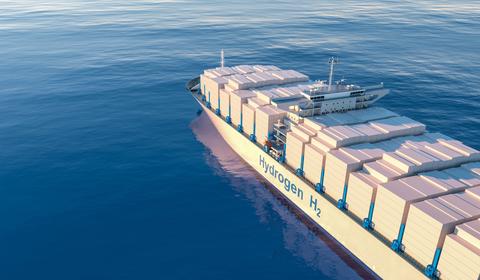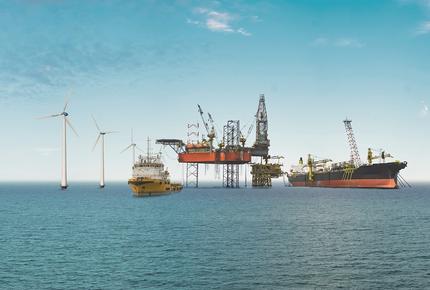
Alternative fuel in focus: hydrogen and the future of shipping
The shipping industry must decarbonize rapidly to meet global net zero targets. However, the way forward does not lie in abandoning existing vessels and creating entirely new ones. Increasingly, owners and operators are turning to retrofitting, a process by which a traditional vessel can be adapted to run on alternative fuels.
One key option among future alternative fuels will be hydrogen, which has the potential to be a completely zero-emission power source if sourced from renewable energy.
The alternative outlook
The shipping industry is exploring low- and potentially zero-carbon fuels. Some, such as e-fuels, methanol or biofuels could offer carbon reductions in a short-to-mid-term timeframe. In the longer term, however, developing zero-carbon options, such as green hydrogen (H2), may gain traction. Up to now, hydrogen fuel cells have made sense for small vessels in particular, such as service boats, inland navigation craft, and small ferries and fishing boats. These do not need to store as much fuel onboard and can refuel more frequently and easily onshore.
For larger vessels, hydrogen fuel cells can currently provide auxiliary power, but not yet the full supply required for long voyages. Projects are under way to adapt hydrogen fuel cells to provide the full volume of propulsion required to completely power cruise ships and containerships, for example.
The biggest challenge in using hydrogen as an alternative fuel is its cost. Currently, yield is low on hydrogen fuel cells, and hydrogen in its liquid or gaseous forms is difficult to handle and less energy dense that traditional marine fuels. Therefore, it is crucial that cost efficiency is considered at every stage of a hydrogen retrofitting project.
Facing the hydrogen hydra
There are several considerations ship owners must therefore factor in before opting to retrofit their ships for hydrogen as fuel.
Not least, is that hydrogen is difficult to transport and store because it is relatively low density. This necessitates large volumes of storage space onboard a ship powered by hydrogen. Furthermore, transporting liquid hydrogen requires very high pressures (between 350 and 700 bar) and low temperatures (-253˚C).
The process is not only complicated logistically, but also from a safety perspective. Hydrogen is highly flammable and potentially explosive, so tightness and containment must be absolute to prevent potential leaks. The flame of burning hydrogen is also invisible, further increasing potential safety risks.
Finally, ports do not yet have the capacity to supply ships with alternative fuels like hydrogen. This makes partnering with and supporting onshore players vitally important for ship owners and operators.
A strong track record in hydrogen
BV Solutions M&O has been at the vanguard of alternative fuel use in the marine industry for years. It has already undertaken important hydrogen projects, such as:
- In 2013, BV Solutions M&O supported Paris’ Bateaux Mouches and NaviBus as they investigated the impact hydrogen fuel cells could have on their emissions.
- In 2021, we helped classify a zero-emission service vessel for a floating wind farm.
- In 2022, we were contracted to support a hydrogen fuel cell retrofit project with technical safety studies
- In 2023, we will provide risk analysis of the H2 system and fuel cells for a high-speed passenger vessel design project in Norway.
Setting sail with hydrogen
Adapting ships to use hydrogen or hydrogen fuel cells begins with a well-defined project approach. Technical advisors can help shipowners stay abreast of existing qualifications so their systems may be adapted to meet regulations, as well as the specific needs of their projects.
Risk analysis is also crucial from the start of any hydrogen project. Hydrogen fuel cells require a full, comprehensive review of all potential risks, due to the challenging nature of hydrogen storage and transportation.
Two further steps are feasibility and integration studies. The latter entails optimizing the integration of hydrogen tanks, process systems and onboard equipment.
BV Solutions M&O: propelling partners into the future
BV Solutions M&O can provide these services and more. We bring our expertise in risk analysis to bear on all hydrogen as fuel projects. Our core areas of expertise—structural engineering and naval architecture—are particularly useful for retrofitting projects.
We have conducted strategy support studies for clients, illustrating hydrogen’s potential to reduce emissions and energy consumption. We have also performed global cost studies, helping owners decide whether to undertake a given project. Our cost analysis is supported by SEECAT, our ship energy modeling software. This is a valuable and innovative tool that strengthens our support for strategy and business plans.
We are also proud to partner with other experts in the field to provide the best insights to clients. For instance, we work with a subsidiary of Europe Technology that specializes in building hydrogen tanks, piping and connecting systems. Our naval architects thus leverage their knowledge to decide how best to integrate such tanks on a ship.
Our extensive expertise in marine applications differentiates BV Solutions M&O from other players. Retrofitting projects require intimate knowledge of naval architecture and the technical requirements of the marine industry. We are performance driven and committed to supporting our clients through the energy transition and into the future.
Global Service Line Lead Risk Services
BV Solutions M&O
From a risk assessment standpoint, the maritime world is going through a huge evolution. The time of a common propulsion solution for all using diesel or heavy fuel is gone. While there’s still some uncertainty about which alternative fuels will take precedence in the future, the industry needs stringent risk assessments to ensure the safety and reliability of the alternative fuel technology being developed. Our experts can analyze the risks and their levels of probability, and propose measures to reduce them.


